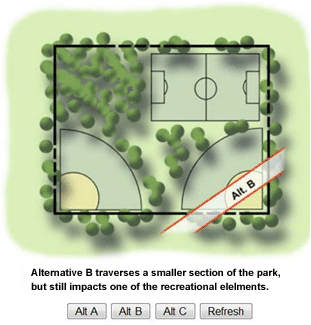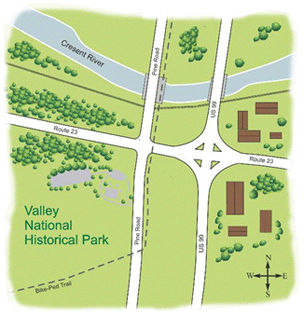Interactive Online Tutorial Educates Users about Section 4(f)
One of the most frequently litigated environmental statutes in the Federal-aid highway program is the complex regulation known as Section 4(f) of the U.S. Department of Transportation Act of 1966. Section 4(f) is a special provision mandating that Departmental Agencies, including the Federal Highway Administration (FHWA), avoid using and minimize harm to significant publicly owned park and recreational lands, wildlife and waterfowl refuges, and publicly or privately owned historic sites considered to have national, State, or local significance in the development of transportation projects. FHWA has developed the Section 4(f) Tutorial, an interactive online tool designed to help transportation professionals grasp the fundamental requirements of Section 4(f).
Recent Changes to Section 4(f)
Section 4(f) has undergone several changes mandated by the Safe, Accountable, Flexible, Efficient Transportation Equity Act: A Legacy for Users (SAFETEA-LU). In 2005, SAFETEA-LU established a simplified process for projects that have only deminimis impacts (those with no adverse effects) on property protected by Section 4(f). In 2008, FHWA and the Federal Transit Administration issued a joint regulation – 23 CFR 774 – to codify this process and to update other aspects of Section 4(f). On July 20, 2012, FHWA published a completely revised and updated version of the Section 4(f) Policy Paper to reflect the latest statute and regulations, as announced in the September 2012 issue of Successes in Stewardship.
Interactive Section 4(f) Tutorial
The Section 4(f) Tutorial can help practitioners:
- Determine what types of properties are included under Section 4(f).
- Review examples of successful projects from different Section 4(f) case studies.
- Define various legal and administrative terms related to Section 4(f).
- Learn about other important statutes relevant to Section 4(f), such as Section 106 of the National Historic Preservation Act and Section 6(f) of the Land and Water Conservation Fund Act.
In March 2013, FHWA launched the online Section 4(f) Tutorial, which expands on a prior version of a Section 4(f) training tool. To develop the new tutorial, FHWA formed an internal task force of experienced Section 4(f) practitioners who wrote new sections of content and tested the tutorial’s features, culminating in the launch of a beta version of the tutorial last fall. After receiving input from both Section 4(f) experts and first-time users, FHWA revised the tool again and made it ready for its public debut.
The new tutorial offers interested individuals and transportation professionals, at all levels of government and industry, an interactive overview of Section 4(f). The tutorial is simple to navigate; it allows users to explore the website either in its entirety or section by section, depending on the individual’s needs and level of familiarity with Section 4(f).
One of the new tool’s greatest strengths is its applicability for a range of potential users, from beginners to Section 4(f) specialists. Tutorial users that are new to Section 4(f) will benefit from the educational resources available through the tutorial. They can view definitions as they read by hovering over important terms or refer to the complete glossary of key terms, linked on the left-hand side of the page. Newcomers will also find the tutorial simple enough to comprehend, and suitably detailed to facilitate real-life work experiences. For example, the tutorial’s concise introductory definition of Section 4(f) property is short enough to read in just a few minutes, but thorough enough to incorporate the entire range of defining criteria. Mid-level transportation planners and those new to environmental coordination and mitigation will appreciate the tool as a means to tie important Section 4(f) concepts into their existing body of transportation knowledge. Section 4(f) experts will value the tutorial as a reference that is both accessible and exhaustive.

In this interactive graphic, users can toggle between three different minimization alternatives to compare the proposed
roadways’ impacts to recreation elements and other resources. (Courtesy of FHWA)

In this example, the replacement of an unsafe bicycle and pedestrian bridge along Pine Road was eligible for a Net Benefit Programmatic Evaluation because of the project’s overall benefits to the park. (Courtesy of FHWA)
The tutorial includes interactive graphics that illustrate complicated planning concepts clearly and comprehensibly. Users can toggle between multiple scenarios within a given image to visualize the potential impacts and alignments of planning alternatives, and understand which are most likely to adhere to Section 4(f) principles.
Section 4(f) Project Examples
The tutorial details four hypothetical examples of Section 4(f) cases that reveal a broad range of considerations and challenges. Each project example focuses on a specific Section 4(f) consideration: de minimis use, least overall harm, creativemitigation, and net benefit.
The tutorial’s net benefit project example describes the replacement of an unsafe bicycle and pedestrian bridge within the boundaries of Valley National Historical Park. The suburban park, which qualifies as a Section 4(f) property, both as a public park and as an historic site, faced two other issues: local traffic was not adequately separated from internal park roads, and an adjacent interchange was geometrically deficient and in need of improvement. The construction of the new bridge and reconfiguration of the nearby traffic interchange required Section 4(f) use of a relatively small piece of park property; however, the project was eligible for a Net Benefit Programmatic Evaluation because the use was offset by the overall benefit to park safety and access.
This case of Valley National Historical Park demonstrates one of the five kinds of nationwide Programmatic Section 4(f) Evaluations. Programmatic Evaluations like this one still require coordination with, and approval by, the officials with jurisdiction, but save time when compared to individual evaluations. They do not require comment periods or circulation among multiple stakeholder agencies, since their approach and basic framework have already been approved by the U.S. Department of the Interior for ease of use in certain standard scenarios. Instead the Programmatic Evaluation is typically approved much faster than an individual evaluation.
Other project examples included in the tutorial detail the case of a de minimis determination for intersection improvements near an historic farm and the determination of least overall harm in the case of a bridge replacement project that required the use of one of two Section 4(f) properties. Together these project examples help users better understand how Section 4(f) may be applied to a variety of common planning scenarios.
Tools for Advancing Stewardship
FHWA’s online materials for Section 4(f), including the Section 4(f) Tutorial and the Policy Paper, are helping practitioners address issues associated with the impacts of transportation projects on parks and other properties protected by Section 4(f). To expand this work, FHWA is collaborating with the National Highway Institute to offer an in-depth Section 4(f) training course beginning late this summer for individuals interested in Section 4(f) principles and applications. These tools help transportation professionals carry out their stewardship roles by ensuring they understand the process to efficiently deliver transportation projects while avoiding and minimizing harm to protected properties.
Contact Information
MaryAnn Naber
Federal Highway Administration
Office of Project Development and
Environmental Review
maryann.naber@dot.gov
(202) 366-2060
Look What’s New!
- In March 2013, FHWA completed the Stochastic Empirical Loading and Dilution Model (SELDM), which replaces the FHWA runoff-quality model (Driscoll) published in 1990. Developed in conjunction with the U.S. Geological Survey, SELDM uses information and data about a highway site, water quality of upstream receiving waters, precipitation events, storm-flow, and the performance of mitigation measures to produce a stochastic population of runoff-quality variables. It is designed to help determine pollutant loading levels for planning or environmental review studies. This robust model is available for use by State DOTs, regulators, and resource-management agencies. To learn more, please visit https://pubs.usgs.gov/tm/04/c03/.
- FHWA recently updated its Questions and Answers on Environmental Justice document on the Agency’s Environmental Justice website. The document sheds light on many aspects of Environmental Justice as they apply to FHWA, as well as recipients of Federal transportation funds.
Successes in Stewardship is a Federal Highway Administration newsletter highlighting current environmental streamlining and stewardship practices from around the country. Click here to subscribe, or call (617) 494-3719 for more information.

